Start Strong: Make Your Health a Priority This Year – Mommy Iris | Top Lifestyle Blogger Philippines

Alaska’s national parks are home to some of the most fascinating wildlife in the world. From massive grizzlies roaming the valleys of Wrangell-St. Elias to humpback whales breaching near the icy waters of Kenai Fjords, there’s always something incredible to see. Denali, with its sweeping tundra and towering peak, offers yet another unforgettable experience for animal lovers.
Staying at a Princess Wilderness Lodge gives you a front-row seat to the action. Strategically located near Alaska’s top parks, these lodges make it easy to fill your days with exploration and return to a comfortable base at night.
Ready to embark on a journey into the wild? Read on to uncover the best spots and seasons for wildlife viewing in Alaska’s incredible national parks.
Wrangell-St. Elias National Park
Photo Credit: Travel Alaska
Wrangell-St. Elias National Park isn’t just Alaska’s largest — it’s the largest national park in the United States, spanning an incredible 13.2 million acres. Its remarkable features and thriving grizzly bear populations earned it UNESCO World Heritage Site status in 1994.
For summer visitors, the Copper River Princess Wilderness Lodge is a great place to stay and be in the heart of the action. Located just four miles from the visitor center, the Lodge offers a host of outdoor activities so you can make the most of Wrangell-St. Elias’s views.
Here’s when to see some of Wrangell-St. Elias National Park’s wildlife:
Spring (April to May)
Spring marks the return of migratory birds, like trumpeter swans, which arrive in mid-April to early May for their mating season. In the 19th and early 20th centuries, the species was believed to have nearly disappeared in North America. It was believed that only 70 wild trumpeters remained when an aerial survey of the Copper River revealed thousands of wild trumpeters thriving in Alaska.
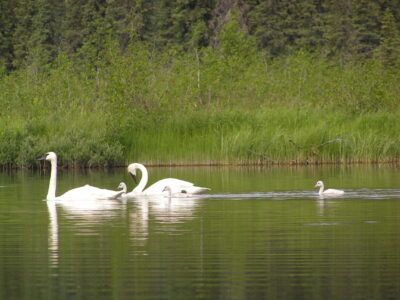
River otters also become more active in spring, moving between land and water as the weather warms and food becomes plentiful. Sometimes these playful swimmers can be elusive but check rivers and shorelines for passing groups.
Summer (June to August)
Like many places in Alaska, Wrangell-St. Elias National Park is a great place to view moose, caribou and Dall sheep in the summer. These animals are emblematic of Alaska, but this park is also home to some less familiar species.
Bison once roamed Alaska in great numbers before overhunting and habitat changes led to their decline. In 1928, they were successfully reintroduced to Wrangell-St. Elias, and today their herds are thriving, migrating through the park in large groups with the changing seasons. Early summer is the best time to catch them grazing along the gravel bars in the Dadina River.
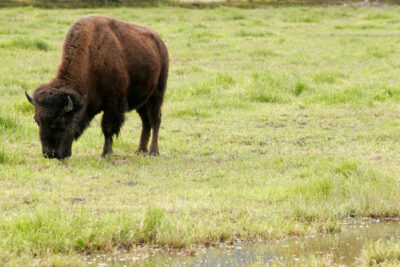
Photo Credit: ©State of Alaska/Brian Adams
In late summer, Copper River is a great place to see spawning salmon. Later in the season, salmon begin to take on a brighter and more distinctive color, appearing as flashes of bright red moving upstream. Sport fishing in Wrangell-St. Elias National Park can be difficult, but the nearby Klutina and Gulkana Rivers have ample opportunity for travelers looking to get their feet wet.
Fun fact: Salmon spend most of their lives in the ocean, but migrate back to the rivers where they were born to spawn. They manage the difficult upriver migration due to their keen sense of smell.
Fall (September to October)
While summer is peak season for animal viewing, travelers coming later in the year can still enjoy great views of brown and black bears in the park. As salmon move upstream to spawn, bears can be spotted along the rivers finding food to fatten up for the upcoming winter.
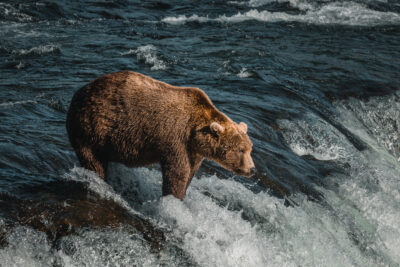
Photo Credit: Travel Alaska
Brown bears and black bears are two distinct species with notable differences. Brown bears, often referred to as grizzlies, are generally larger and can be identified by their prominent shoulder hump and rounded ears. Black bears, on the other hand, are smaller, with straight facial profiles and no shoulder hump. Despite their name, black bears can range in color from black to brown, cinnamon and even blonde. The best way to see bears in action is by joining a guided tour, where local experts can take you to the most active spots for wildlife.
Safety tip: For your safety, be sure to maintain at least 100 yards of distance between yourself and any bears. Even smaller black bears can be aggressive when threatened.
Alaska’s smaller residents often fly under the radar but are worth the effort to spot. Hoary marmots, one of the largest members of the squirrel family, are known for their loud, whistling calls used to alert others to potential danger. These burrowing animals are typically found in rocky areas and alpine meadows, making early mornings and late afternoons the best times to catch a glimpse of them.
Northern flying squirrels are nocturnal creatures that glide between trees using a skin membrane stretched between their limbs. While harder to spot due to their nighttime activity, they can often be found near forested areas. Look for their nests, which are usually built in tree cavities or old woodpecker holes.
Winter (November to March)
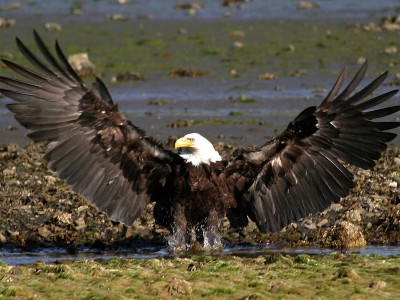
While most wildlife hibernates during the snowy season, the bald eagle is viewable in Alaska year-round. In fact, bald eagles are more abundant in Alaska than anywhere else in the nation. Known for their striking white heads and impressive wingspans of up to nearly 8 feet, they are often seen near fish runs, rivers and coastlines. Their distinctive high-pitched calls and soaring flights make them a highlight for wildlife watchers.
Denali National Park
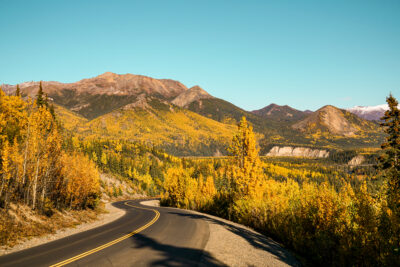
Denali National Park is six million acres of wild land, containing North America’s tallest peak. At 20,310 feet, Mount Denali can be visible as far south as Anchorage on clear days. The park varies from low-elevation taiga forest to high tundra and mountains. There is only one road through the park, which allows for incredible wildlife viewing across its length.
The Denali Princess Wilderness Lodge is the closest and most comfortable place to stay when visiting the park. The entrance to Denali National Park is located only a mile from the Lodge, and the Lodge’s expansive viewing deck offers a great spot to relax and look for wildlife from a distance.
Here’s how to make the most of your viewing in any season:
Spring (April to May)
Spring is short in Alaska. Temperatures warm in April, and snow begins to disappear by mid-May. This short transition season brings substantive changes to the landscape, welcoming back migrating animals and awakening hibernators.
Caribou can be spotted in alpine areas like the Highway Pass and Thoroughfare Pass in the park, though smaller groups sometimes wander closer to the park entrance. Known for their long migrations, caribou can travel up to 50 miles a day during seasonal movements.
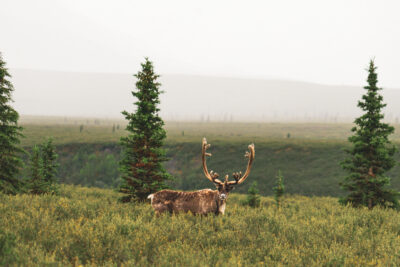
Moose, the largest members of the deer family, are year-round residents of Denali and are frequently seen in the first 15 miles of the Park Road, where they forage on willow, birch and aspen. In spring, they often venture closer to the park entrance and areas like the Denali Visitor Center and Riley Creek Campground. Standing over six feet tall at the shoulder and weighing up to 1,600 pounds, moose are surprisingly agile swimmers, capable of crossing lakes and rivers to find food or shelter.
Viewing tips: When viewing from a distance, caribou and moose can be hard to spot. Be patient, quiet and use binoculars for a better chance of spotting them.
Summer (June to August)
Increased daylight means increased activity for Denali’s “Big Five” –– moose, bear, caribou, Dall sheep and wolves –– all of which are visible inside the park and preserve. Some, like wolves, are more elusive than others. Riding the bus along Park Road is one of the best ways to see them, as the route passes through various habitats ideal for wildlife viewing. Keep binoculars handy and be ready for surprises, wildlife often appears when you least expect it.
Avid and amateur birders alike can find a birdwatching paradise in Denali National Park. Alaska’s state bird, the willow ptarmigan, are year-round residents in the park. These vocal birds change the color of their plumage with the seasons to evade predators like golden eagles or red foxes.
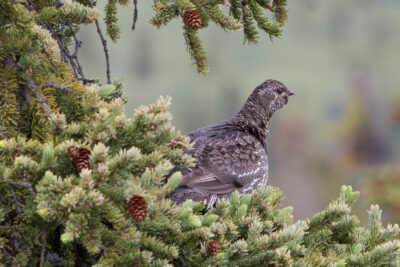
Photo Credit: ©State of Alaska/Jocelyn Pride
Equally abundant, the common raven lives year-round in Denali. Famously intelligent birds, ravens also feature prominently in the history and literature of many Alaska Native tribes. The raven is seen as the creator of the world and the bringer of daylight, as well as a clever trickster.
Fall (September to October)
In the fall, moose tend to congregate between Miles 9 and 13 of the Park Road for rutting season. Before shedding their antlers in the winter, male moose engage in spars, which see them collide head-first in displays of dominance.
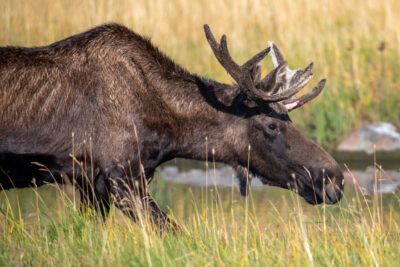
Viewing tip: If you spot shed antlers in the park, leave them be. While these may seem like the perfect souvenir, it’s illegal to remove them from the park.
Winter (November to March)
In the winter, parts of Denali National Park close due to heavy snow and reduced visitor traffic. But for park rangers, the work continues. Winter travelers can expect to enjoy the trails park rangers and their sled dogs groom all season long. Sled dogs have been an important part of Denali’s history for more than 100 years. Though the kennels are open year-round to visitors, winter visitors get the chance to see these animals doing what they love most: running.
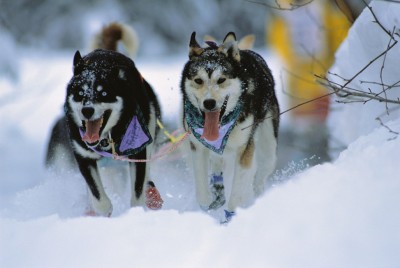
Kenai Fjords National Park
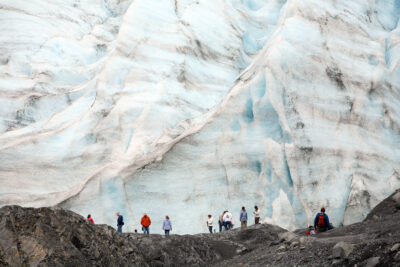
Photo Credit: ©State of Alaska/Brian Adams
At the edge of the Kenai Peninsula, Kenai Fjords National Park is home to nearly 40 glaciers flowing from the Harding Icefield. The park extends toward the shore, where diverse marine ecosystems host a variety of birds and mammals.
The Kenai Princess Wilderness Lodge is well-positioned against the Kenai River and offers modern amenities among 47 acres of wilderness. With many optional excursions, the Lodge has experiences for guests looking to maximize wildlife viewing.
Spring (April to May)
Though widely known as killer whales, orcas are members of the dolphin family. Orcas do not have any predictable migration pattern, but peak viewing season is between mid-May and June. Their sleek black-and-white coloring and tall dorsal fins make them a striking sight against the icy waters of Kenai Fjords.
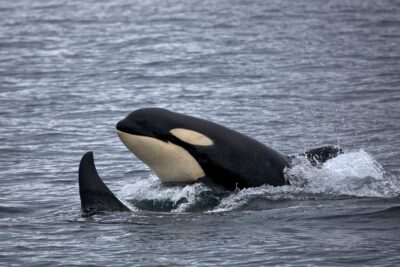
Photo Credit: National Parks Service/ Kaitlin Thoresen
Like orcas, Peale’s peregrine falcons are exceptional predators. The Peale’s peregrine falcon is unique to the Seward area near the park, and these birds are the largest and darkest-feathered of the peregrines. Peale’s peregrine falcons stay in Alaska year-round and can be spotted in Emerald Cove. Look closely: these birds can fly as fast as 220 miles per hour when hunting.
Summer (June to August)
Steller sea lion can be found in the coastal waters of Kenai Fjords National Park. Steller sea lions are the largest member of the sea lion and fur seal family, with female sea lions weighing up to 2,400 pounds. Viewers looking to catch a glimpse of these giant “seawolves” should look on large rock islands on the east side of Resurrection Bay and the north end of Emerald Cove. You can also catch a glimpse of them from the south side of No Name Island.
Both tufted puffins and horned puffins are a highlight of Kenai Fjords National Park, where they thrive along rocky cliffs and islands. These seabirds are easily recognized by their distinctive features — tufted puffins with their golden head feathers and horned puffins with bright orange beaks and unique fleshy “horns” above their eyes during breeding season. Visitors can spot them from tour boats or perched on the cliffs of the Beehive Islands, named for the constant flurry of puffin activity.
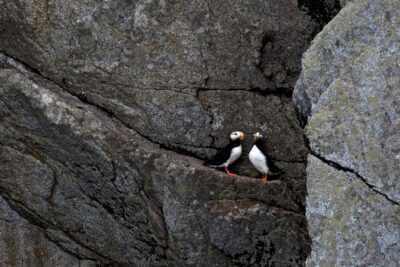
Photo Credit: National Parks Service / Kaitlin Thoresen
Humpback whales spend their summers in Kenai Fjords feeding on roughly a ton of krill, copepods and small fish each day. These massive mammals are known for their acrobatic breaches and tail slaps, which are often visible in Resurrection Bay and the waters surrounding the park. Visitors can watch humpbacks from tour boats, or with patience, spot them near the coast using binoculars. Their signature spouts and massive dorsal fins are often the first sign of their presence.
Viewing Tips: When viewing whales, be persistent. Humpback whales have a downtime of between 3-8 minutes before they must return to shore for breath.
Fall (September to October)
In early fall, Harbor seals can be spotted on boulders or ice flows during their fall molt. This time of year is molting season, when seals rapidly lose their fur in patches, allowing a whiter, thicker winter coat to grow in. Spot them on Thumb Cove and Humpy Cove on the east side of Resurrection Bay or on the west side of Bear Glacier.
Winter (November to March)
Though easily confused for Alaska’s iconic Dall sheep, mountain goats are the only white, hoofed animal in Kenai Fjords National Park. Kenai Fjords mountain goats belong to a subgroup known as “goat-antelopes,” and fare well in the snowier, wetter climate because of their size and strength. In the winter, mountain goats descend to at or below tree level to find the scarce vegetation. Looks closely – can you spot the mountain goat?
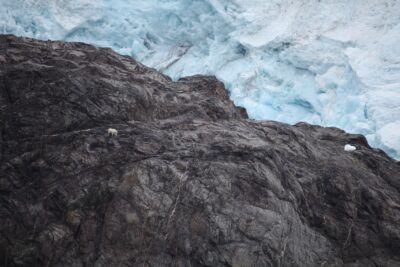
Photo Credit: National Parks Service/Jim Pfeiffenberger
Alaska is wild –– and so are its animals. When you set out on your wildlife viewing adventure, remember:
- Keep your distance. This keeps you and the animals safe.
- Always consult local guides about current wildlife warnings. Guides know best which high-activity areas are unsafe to visit.
- Take your time. Wildlife viewing can be slow, and nothing is guaranteed. Take your time looking for wildlife and enjoy the views.
Alaska’s wildlife is as unforgettable as its landscapes, and there’s no better way to experience both than by staying at a Princess Wilderness Lodge. Conveniently located near some of Alaska’s most iconic national parks, the lodges offer the perfect mix of comfort and adventure. Whether you’re exploring Denali, Kenai Fjords or Wrangell-St. Elias, these lodges put you right in the heart of the action.
Publisher: Source link
Latest Posts
-
31 July 2025
-
26 July 2025
-
14 July 2025
-
01 July 2025
-
07 August 2025
-
29 July 2025
-
20 February 2025
-
04 February 2025
Newsletter
Sign up for free and be the first to get notified about new posts.
Get The Best Blog Stories into Your icountox!
Sign up for free and be the first to get notified about new posts.










